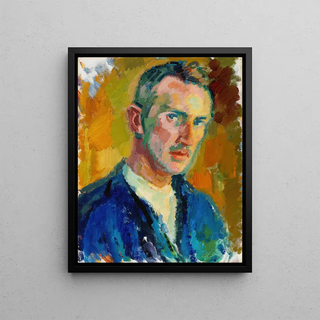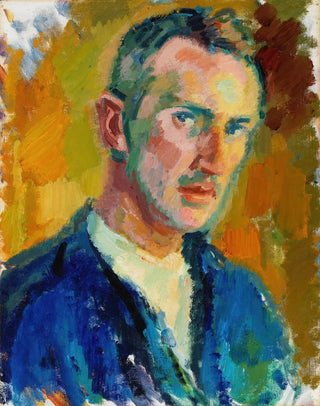Art print | Self-portrait - Magnus Enckell


View from behind

Frame (optional)
Magnus Enckell's Self-portrait is a work that transcends the simple exercise of personal representation to immerse the viewer in an introspective and poetic universe. Created by this Finnish artist in search of identity, this self-portrait is an open window to his soul, an invitation to explore the twists and turns of the human psyche. The piece, both vibrant and unsettling, captures attention through its emotional intensity and refined aesthetic. Through this work, Enckell does not merely depict himself; he engages in a dialogue with the viewer, encouraging reflection on the nature of identity and art.
Style and uniqueness of the work
The Self-portrait stands out with a style that combines symbolism and impressionism, two artistic movements that have profoundly influenced Enckell's journey. The chosen colors, both warm and cool, create an ambivalent atmosphere, oscillating between light and shadow, happiness and melancholy. The brushstrokes, delicate yet assertive, demonstrate technical mastery that captures the subtleties of human emotions. The composition, focused on the artist's face, evokes deep introspection, while the surrounding elements, blurred and suggestive, reinforce this impression of a rich and complex inner world. Enckell thus manages to establish a perfect balance between abstraction and figuration, offering a work that resonates with timeless modernity.
The artist and his influence
Magnus Enckell, an emblematic figure of Finnish art in the early 20th century, belongs to a lineage of artists who redefined the boundaries of painting. Influenced by masters such as Vincent van Gogh and Paul Gauguin, Enckell develops a unique style characterized by a constant exploration of color and light. His commitment to symbolism manifests in recurring themes such as the quest for self and spirituality, elements also found in the Self-portrait. Enckell does not limit himself to a simple representation of himself;

Matte finish

View from behind

Frame (optional)
Magnus Enckell's Self-portrait is a work that transcends the simple exercise of personal representation to immerse the viewer in an introspective and poetic universe. Created by this Finnish artist in search of identity, this self-portrait is an open window to his soul, an invitation to explore the twists and turns of the human psyche. The piece, both vibrant and unsettling, captures attention through its emotional intensity and refined aesthetic. Through this work, Enckell does not merely depict himself; he engages in a dialogue with the viewer, encouraging reflection on the nature of identity and art.
Style and uniqueness of the work
The Self-portrait stands out with a style that combines symbolism and impressionism, two artistic movements that have profoundly influenced Enckell's journey. The chosen colors, both warm and cool, create an ambivalent atmosphere, oscillating between light and shadow, happiness and melancholy. The brushstrokes, delicate yet assertive, demonstrate technical mastery that captures the subtleties of human emotions. The composition, focused on the artist's face, evokes deep introspection, while the surrounding elements, blurred and suggestive, reinforce this impression of a rich and complex inner world. Enckell thus manages to establish a perfect balance between abstraction and figuration, offering a work that resonates with timeless modernity.
The artist and his influence
Magnus Enckell, an emblematic figure of Finnish art in the early 20th century, belongs to a lineage of artists who redefined the boundaries of painting. Influenced by masters such as Vincent van Gogh and Paul Gauguin, Enckell develops a unique style characterized by a constant exploration of color and light. His commitment to symbolism manifests in recurring themes such as the quest for self and spirituality, elements also found in the Self-portrait. Enckell does not limit himself to a simple representation of himself;






